Where to buy herbs… let’s settle the debate! Here are the best 11 places to buy herbs online, tips for growing your own, plus how to find high-quality, organic, non-GMO herbs at the grocery store, farmers market, or nursery!
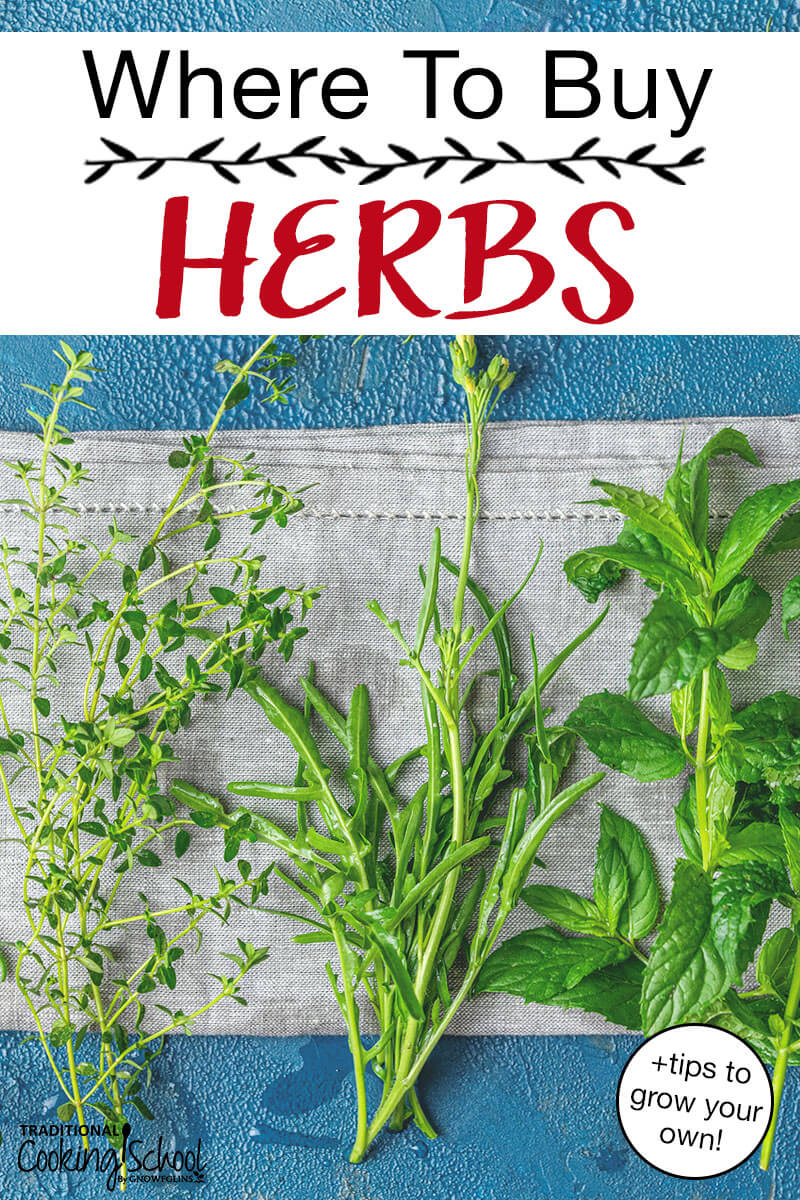
Where is the best place to buy herbs? And how can we be sure they are high-quality and free of pesticides?
We’ll answer these questions, and more, in today’s post!
This is the Local Food 101 series, where we’ll cover types of local food, along with the particular questions you can ask to determine the quality of the food being offered. We have already covered chickens and eggs, beef, and fruits and vegetables.
In this post we’ll tackle herbs!
Table Of Contents
What Are Herbs?
Herbs include any plant whose seeds, flowers, or leaves are used for flavoring, food, medicine, or perfume. It’s quite the big list!
We’ll refer to culinary herbs — such as basil, thyme, marjoram, sage, mint, etc. — in this post, but this information applies to any other herbs as well.
Important Things To Know About Herbs
Herbs have a variety of uses. Besides boasting amazing flavor, herbs offer an abundance of health benefits.
Many people ask, “Are herbs the same as medicine?”
The technical answer is no, however, herbs can be used in a medicinal way. Not just in the form of herbal supplements and home remedies but also as a way to elevate our food.
After all, food is medicine, right? Or at least it can be.
We know the incredible impact a traditional real food diet can have on our health — herbs are an important part of that!
In most instances, herbs used in a culinary fashion are considered safe. However, if you delve into using herbs in a more medical manner, and begin creating homemade remedies, it’s important to do some research about any herb you use.
Herbs are powerful substances and some can interact with medications. When using herbal supplements, search this drug interaction checker to seen if there are any potential issues with medications you take.
Organic Vs. Non-Organic
It’s always a good idea to buy organic herbs when possible. As with most food, organically grow varieties tend to have a lot more flavor and nutritional value.
Besides that, organically grown foods allow you to avoid the toxins and chemicals associated with conventional growing methods.
However, it’s important to note that many locally-sourced fresh herbs, such as those from the farmers market, may not have organic certification even though they are grown using organic practices.
Organic certification can be costly and is often out of reach of smaller growers and companies. This is why we recommend asking local farmers and sellers about their growing practices.
When it comes to organic vs. non-organic, consider what is used in the soil as well as what is sprayed on the plant itself. Choose herbs grown without heavy pesticide sprays or toxic soil additives when you are able to do so.
GMO Herbs
It is hard to avoid genetically modified organisms (GMOs) these days. It is something to consider when buying food, plants, and seeds.
When growing herbs at home, many struggle to find non-GMO seeds. Thankfully, a number of companies strongly commit to selling only non-GMO seeds.
Similarly, many sellers of dried and fresh herbs are also steadfast in their pursuit of high-quality, non-GMO herbs.
Where to find non-GMO seeds for growing herbs
Where to find non-GMO dried herbs
Where to find non-GMO fresh herbs
When it comes to fresh herbs, you will need to dig a little deeper. Ask questions of the company you buy from to discover whether or not they grow herbs from GMO seeds.
A little internet slue-thing can also help uncover the growing practices of some companies. The Non-GMO Project is a good place to search when looking into brands available online and in grocery stores.
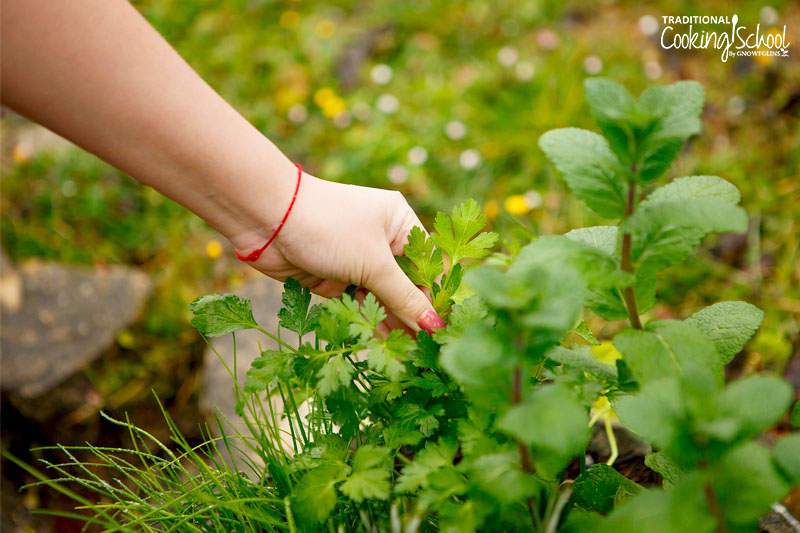
Where To Buy Herbs?
When it comes to buying herbs, we have a lot of options.
Herbs are available at the grocery store, farmers market, local nursery, online, and even in our own backyards. Depending on your location, you may choose to buy herbs at all of these places!
Let’s tackle each option for buying herbs so you can know what to look wherever you find yourself shopping.
#1 — Buying Herbs From The Grocery Store
Buying fresh herbs from the grocery store is one of the most expensive ways to get them. Aside from a bunch of parsley or cilantro, which are often reasonably priced, most culinary herbs are a few dollars for a minuscule amount!
Dried herbs can also be fairly expensive at grocery stores, and add up quickly! Just think about a new recipe with five herbs not currently in your pantry!
However, sometimes it’s our only option.
When it comes to buying dried herbs at the grocery store, organic is best, whenever possible. Simply Organic is one of the more affordable organic brand and is available in many areas.
To save money, consider buying the less expensive herbs at the grocery store and seek online options for the more expensive varieties.
When buying fresh herbs from the grocery store, look for organic options when possible and check the condition of the herbs before purchase. Herbs should appear vibrant and fresh, not wilted or brown.
Wash all herbs you buy from the grocery store and use careful storage practices to get the most out of your purchase.
For the best price, check the marked-down items in the refrigerated and produce areas. Fresh herbs are often included there , but may be close to going bad, so will need to be used immediately, or frozen or dried for storage.
#2 — Buying Herbs From The Farmers Market
The farmers market is one of the best resources for fresh, reasonably priced herbs. Since these herbs are grown locally, they are often the freshest and most flavorful option as well!
Keep in mind that not all herbs at the farmers market are grown organically. It’s important ask questions or do some research in order to know what you are getting.
Similarly to buying fruits and vegetables, make sure the soil is cared for and that chemical sprays are not used on the herbs.
You can tell if they are in good condition by making sure the herbs are not slimy, dry, or wilted. It only takes a quick glance and you’ll know whether the herbs are fresh and healthy!
How Did The Farmer Grow The Herbs?
In pots? What soil did they use?
Herbs are often grown in containers instead of the ground, so ask if they were potted, and find out what type of soil was used to grow them. Was it commercial potting soil with additives, compost from the farmer’s backyard, or some other soil?
How To Get The Best Price
Herbs are often sold as potted plants at the farmer’s market. While this is attractive and charming, and a great option if you plan to plant and care for the herb, it can make them more expensive since you’re paying for the potting materials as well as the herbs.
If you care for the herb all season long and enjoy using it in the kitchen, the investment may be worthwhile. However, in my experience, they won’t last for more than a meal or two since one recipe can consume an entire plant.
If you’re set on buying a potted herb, be careful to use only a few sprigs at a time.
To get the best price at the farmers market, buy small bundles of herbs. Besides being the most inexpensive and cost-effective option, this also gives you the best opportunity to use all of the herb before it goes bad.
Herbs seem to be a less popular farmers market item, and many farmers are very happy to give discounts if you offer to buy large amounts. So, be sure to ask!
Herbs are easily dried (see the Dehydrating eCourse) — or freeze them in olive oil-filled ice cube trays.
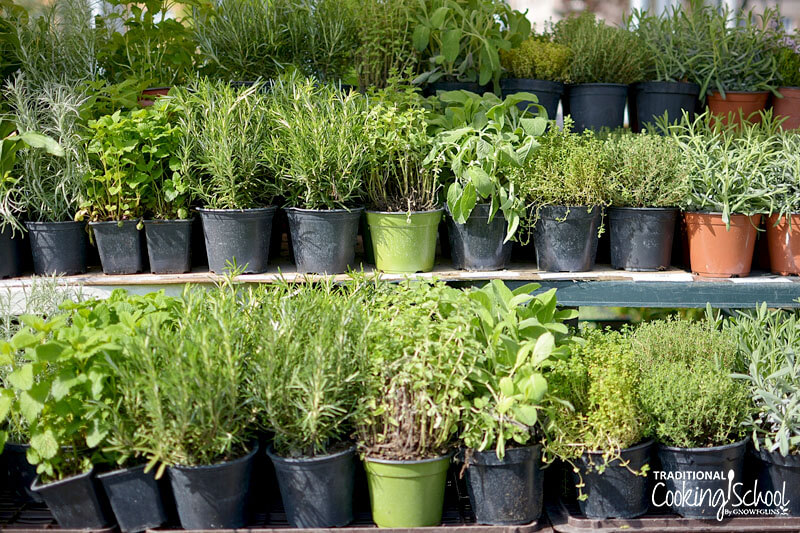
#3 — Buying Herbs From A Nursery
The quality and variety of herbs available at local nurseries vary greatly. Some nurseries are dedicated to natural and environmentally-friendly growing practices, while others are more conventional and utilize pesticides and herbicides.
Just as you would at the farmers market, it’s important to ask questions or do some research in order to know what you are getting. Ask about what type of soil was used and how the soil is cared for.
Also inquire about growing practices, especially whether chemical sprays are used.
Always check to see that the herb looks in good health before purchasing. It’s much easier to keep an herb plant alive that to bring it back from the brink of death!
#4 — Buying Herbs Online
Buying herbs online is a convenient option that also allows for a broad selection. Fresh herbs, plant starts, dried herbs, and seeds are all available for online ordering.
Find some of our favorites below:
Azure Standard
Azure Standard has a wide variety of dried herbs available, as well as some fresh culinary herbs, such as parsley and cilantro.
From mid-March through June, Azure Standard also carries a great selection of live plant starts which are an excellent option for those looking to plant an herb garden or simply have a couple of favorites in a planter.
The live plants are grown by Azure’s sister company, Ellie’s Eden, which provides heirloom, organic, and non-GMO live plant starts.
Starwest Botanicals
Wardee often buys her bulk, dried herbs, and spices from Starwest Botanicals. Their organic (they also sell non-organic) herbs are affordable and high-quality.
Frontier Co-Op
Another great choice for buying dried herbs online, Frontier Co-Op sells organic (and non-organic) herbs in bulk at reasonable prices. Wardee frequently purchases herbs from Frontier.
If you are able to get a group together, Frontier Co-Op has wholesale options. Learn more in our post: How to Start a Bulk Food Co-Op.
The Grower’s Exchange
An excellent source for buying culinary and medicinal herbs, The Grower’s Exchange is located on the James River in Virginia and ships live herb plants all across the United States.
The Growers Exchange uses healthy growing practices and avoids harsh chemical pesticides and herbicides.
Their website is a fun resource for those who are not sure which herbs they’d like to buy, as it allows readers to view herbs by category (such as culinary, medicinal, aromatic, flowering, and so on).
View herbs by trait as well, such as those that attract pollinators, deer resistant herbs, drought-tolerant herbs, easy to grow herbs, edible flowers, herbs safe for pets, herb plants by zone, and more! This is a great way to find suitable herbs you may not have considered!
Crimson Sage Nursery
This medicinal plant nursery is located in Orleans, CA, and run by Herbalist, Tina Glaessner. Crimson Sage offers a wonderful variety of certified organic medicinal plants and they ship from late March through late November.
When shopping, filter plants by helpful categories such as Ayurvedic herbs, Chinese herbs, Native American herbs, medicinal trees and scrubs, and more. The website also provides useful articles on growing herbs.
Mountain Valley Growers
Located in California’s Central Valley, Mountain Valley Growers sells USDA-certified organic live herb plant starts.
Companion Plants
A large herbal nursery just outside Athens, Ohio, Companion Plants offers over 600 varieties of common and exotic herb plants and over 200 varieties of seed! Plants are grown using environmentally-friendly practices.
Richters
A great option for our Canadian friends, Richters ships live herb plant starts all across Canada. They also sell bulbs, roots, seeds, and gardening supplies.
Thrive Market
Thrive Market is a great option for buying organic dried herbs online. They have a good selection of most staple culinary herbs and offer reasonable prices.
Territorial Seed Co.
An excellent resource for herb seed, Territorial Seed Co. carries a variety of culinary herb options.
Seed Savers
Seed Savers is a nonprofit company that “aims to conserve and promote America’s culturally diverse but endangered garden and food crop heritage for future generations by collecting, growing, and sharing heirloom seeds and plants.” (Source.)
#5 — Wild/Foraged Herbs
Herbs found in the wild are sometimes foraged and sold at farmer’s markets as well. You can buy delicious, unique, and eclectic local herbs this way, but it is wise to ask the farmer where the herbs were foraged and what they know about the land.
For example, chemicals or pesticide runoff from nearby conventional crops may contaminate herbs gathered from a ditch, pond, or field.
I wouldn’t rule wild herbs out completely, but do ask where they were found. If the farmer foraged them from his own land or somewhere he knows to be chemical-free, enjoy the beautiful wild-grown herbs!

Growing Your Own Herbs
If you use herbs often, it may be cost-effective to grow your own.
This doesn’t mean you need to start a massive herb garden — it could simply be a select few of your favorite herbs in a pot on the back porch. A small grouping of your favorite herbs indoors is also an option.
Growing herbs (and vegetables) is also part of our plan to nourish a large family on a small budget.
To help you figure out if growing herbs is a good option, I’ll answer some of the most frequently asked questions below. That way you can evaluate your situation and see if it’s right for you.
Which herbs are easiest to grow?
To begin with, most herbs are easier to grown than many vegetables, so you’re already ahead! Easy to grow herbs include:
- Basil
- Chives
- Lemon balm
- Mint (Sometimes too easy! It can really spread and take over!)
- Oregano
- Parsley
- Thyme
- Sage
What are the best herbs to grow at home?
Whichever herbs you use the most, or that will save you money, or that are difficult to find.
Growing herbs that are otherwise expensive or difficult to buy is a great option. Not just for saving money, but also for convenience.
Just think how nice it is to walk outside and snip a few sprigs of fresh herb to use at dinner instead of driving to store and paying too much, then worrying about using it all up before it goes bad.
In my area, some herbs, like French tarragon, are virtually impossible to find. I love this herb, especially in these 30-Minute Smashed Baby Potatoes, so growing it in my own backyard makes a lot of sense.
Need ideas? Consider some of the herbs found in these posts:
- 10 Herbs For Herbal Iced Tea… All Summer Long!
- 10 Herbs For Healthy, Glowing Skin
- Spotlight on Herbs: Thyme
- 10 Herbs For Better Sleep (& How to Use Them)
- 10 Herbs For Healthy Teeth & Gums
- Spotlight on Herbs: Rosemary
What herbs does every chef have in their garden?
If you love to cook, having chef-approved culinary herbs at your fingertips will greatly enhance any meal! Favorite herbs many chefs have in their gardens include:
- Basil
- Chives
- French tarragon
- Mint
- Oregano
- Parsley
- Rosemary
- Thyme
- Sage
What are the best medicinal herbs to grow?
The best medicinal herbs to grow are the ones you use most often. Medicinal herbs are excellent resources for cold and flu season.
You can also use medicinal herbs to create teas, tinctures, salves, balms, and more.
Some of the best medicinal herbs to grow include:
- Calendula — A favorite for all manner of skin issues. Use in homemade salves, but also wonderful in tea… including bath teas!
- Chamomile — Use for skin issues, in teas and tinctures for tummy complaints, and in baths and bedtime preparations for restful sleep.
- Echinacea — A wonderful immune support. Include in echinacea tincture and tea blends.
- Lavender — Nice to have in abundance because of its many varied uses.
- Lemon Balm — Excellent for mood support and digestive complaints.
- Sage — A great culinary herb, also eases sore throats.
- St. John’s Wort — Use for mood support and muscle aches. Fresh flowers make the best infused St. John’s Wort oil.
- Yarrow — Easy to grow, works well for skin issues. Makes a great soothing salve for varicose veins.
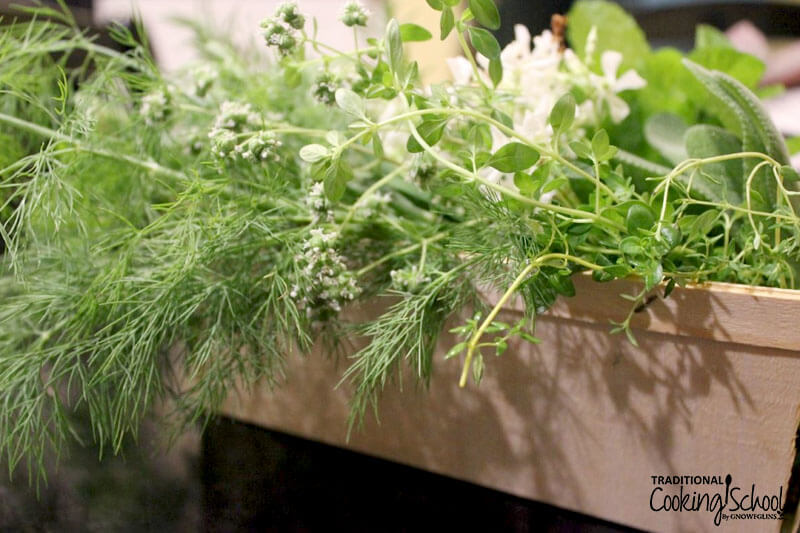
What are your favorite herbs to grow?
I am a family herbalist and also love cooking, so people often ask me about my favorite herbs. You didn’t ask, but I’m going to share anyway!
- Basil — So delicious and adds a ton of flavor to salads, sandwiches, and baked dishes.
- Chives — The flowers are so pretty and chives taste great in eggs and salad dressings.
- Lavender — For home remedies, DIY body care products, relaxing bath teas, and natural decor.
- Oregano — I use this often in homemade pasta sauce, pizza, a variety of other main dishes, and salad dressings.
- Sage — Delicious in homemade breakfast sausage!
- Rosemary — Great for many main dishes, seasoning mixes, and also useful for natural hair care products.
- Mint — A favorite for tea and refreshing bath soaks.
What are examples of perennial herbs?
Perennial herbs come back each year and do not need to be replanted annually. This can vary somewhat according to your location, but in general, perennial herbs include:
- Chives
- French Tarragon
- Lavender
- Mint
- Rosemary
- Sage
- Thyme
- Winter Savory
Perennial herbs help you grow herbs sustainably, so you never run out! This will still require some preservation, such as drying and freezing, as plants go dormant in the winter.
A selection of your favorite perennial herbs will keep you in good supply.
What kitchen herbs can survive in winter?
In most cases, perennial herbs are those that can survive winter. This will vary according to how cold the winter is in your area.
In general, the following herbs survive cold temperatures quite well:
- Chives
- Lavender
- Mint
- Oregano
- Sage
- Thyme
Where can I get herbs for a home garden?
As mentioned above, local nurseries, farmer’s markets, and online retailers are great resources for buying herbs for your at-home garden. It is easy to purchase seeds and live plant starts these days.
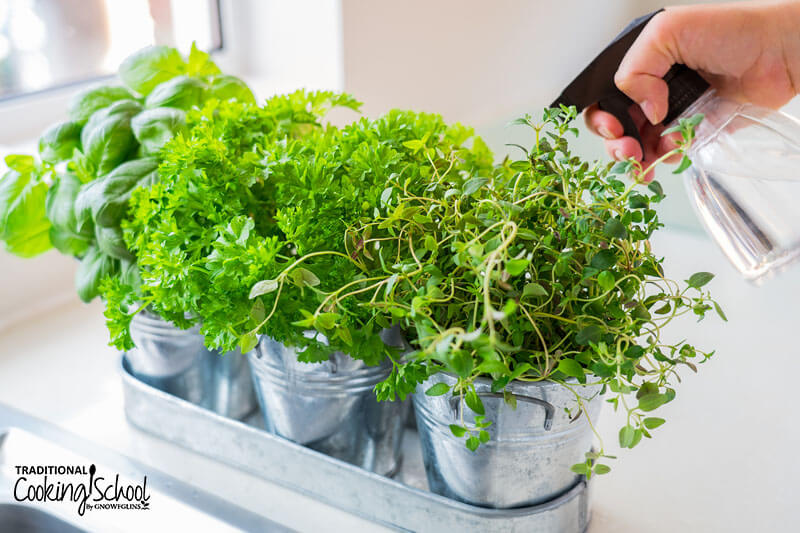
What herbs grow best indoors?
Creating a small kitchen garden and growing plants is a great way to have easy access to the herb you use most. These herbs still need a decent amount of sunlight and regular care.
Some of the best herbs to grow indoors include:
- Basil
- Chervil
- Chives
- Mint
- Oregano
- Parsley
- Thyme
Are the grow-your-own herb kits worth the money?
This is very individual. You can most certainly create similar kits yourself for less, but if you are very new, extremely busy, and don’t feel you have time to hunt down supplies, it may be worth it to you.
Which herbs are best to plant from seed?
Starting herbs from seed is one of the least expensive ways to grow an abundance.
Some seeds can be direct sown, while others should be started indoors. While many seeds can be direct sown if you wait long enough, some are so slow to grow from seed, that it’s best to start them early indoors.
The best herbs to start from seed, which can be direct sown after the last frost include: chamomile, cilantro, dill, summer savory,
The best herbs to start from seed, which should be started indoors include: basil, chives, lemon balm, oregano, parsley,
Which herbs are best to buy as starts?
Herbs that are slower to grow are best to buy as starts. For example, sage takes approximately two years to come to full size. There is nothing preventing you from starting slow-growing plants from seed if you desire to do so.
Some of the best slow-growing herbs to buy as starts include: rosemary, sage, thyme.
Other plants to buy as starts include those that are difficult to grow true-to-type from seed, such as specific varieties of mint (like chocolate mint). This is because they easily cross-pollinate when grown from seed, and the end is often not what you hoped for.
Examples of these include: Lemon verbena, French tarragon, and Mint varieties (regular mint is fine to grow from seed).
What are your favorite herbs to purchase? How do you like to use them?
For high-quality dried herbs and spices, we recommend: Frontier Co-Op, Starwest Botanicals, and Azure Standard.
This post was originally published and written by Jenny Cutler on 6/24/14. It was updated and republished on 6/19/20.
...without giving up the foods you love or spending all day in the kitchen!

2 free books:
Eat God's Way
Ditch the Standard American Diet, get healthier & happier, and save money on groceries...
We only recommend products and services we wholeheartedly endorse. This post may contain special links through which we earn a small commission if you make a purchase (though your price is the same).


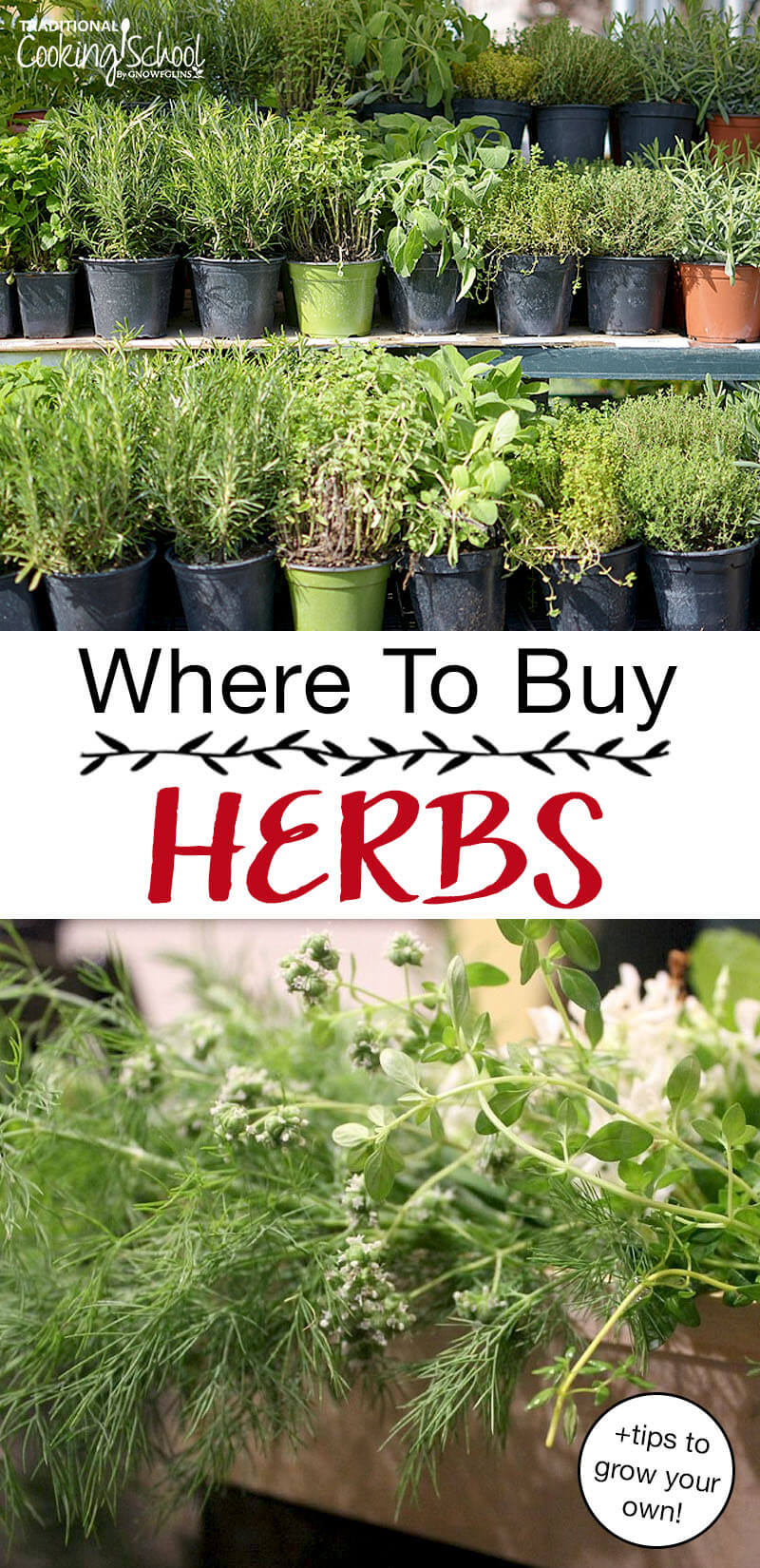
I recently purchased three large(ish) pots of basil to put in my garden. We have a large garden and I could have probably started them myself but they were a nice size and we wanted the basil right away. 😉 I also purchase things like ginger (not nececessarily an herb I guess) and herbs that don’t grow as well here such as cilantro. We use a lot of fresh herbs in the summer with tomato salads and salsa.
I didn’t see any reference to Mountain Rose Herbs. Did I miss it?
I had the same question as Rose. 🙂